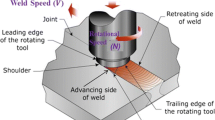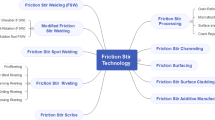Abstract
This study explores the thermal distribution of high-strength engineering alloys during the friction stir welding process (FSW). Materials which are difficult to weld or are unweldable by conventional welding processes can be successfully welded by FSW. The specific analysis and modification of the process require an understanding of the actual mechanism of the process. Therefore, a transient, three-dimensional, thermo-mechanical finite element model (FEM) for FSW was developed. The model calculates the temperature distribution during the welding process considering various boundary conditions such as rotational speed, linear speed, normal pressure, tool diameter and material properties. The thermo-mechanical FEM calculations consider the effects of conduction and convection heat transfer. The numerical results are successfully compared and validated by experimental results published in the literature for aluminium alloy, titanium alloy and steel (mild and bainitic) as workpiece materials. The model was found to be useful for understanding the effects of changes in different system parameters, and for selecting the optimum welding conditions before undertaking high-cost physical testing.










Similar content being viewed by others
References
Mahoney MW, Rhodes CG, Flintoff JG et al (1998) Properties of friction-stir-welded 7075 T651 aluminum. Met Mater Trans A 29:1955–1964. https://doi.org/10.1007/s11661-998-0021-5
Rhodes CG, Mahoney MW, Bingel WH et al (1997) Effects of friction stir welding on microstructure of 7075 aluminum. Scr Mater 36:69–75. https://doi.org/10.1016/S1359-6462(96)00344-2
Do Vale NL, Torres EA, de Santos TFA et al (2018) Effect of the energy input on the microstructure and mechanical behavior of AA2024-T351 joint produced by friction stir welding. J Braz Soc Mech Sci Eng 40:467. https://doi.org/10.1007/s40430-018-1372-5
Patil S, Tay YY, Baratzadeh F, Lankarani H (2018) Modeling of friction-stir butt-welds and its application in automotive bumper impact performance Part 1. Thermo-mechanical weld process modeling. J Mech Sci Technol 32:2569–2575. https://doi.org/10.1007/s12206-018-0514-0
Altenkirch J, Steuwer A, Peel M et al (2008) The effect of tensioning and sectioning on residual stresses in aluminium AA7749 friction stir welds. Mater Sci Eng A 488:16–24. https://doi.org/10.1016/j.msea.2007.10.055
Leonard AJ, Shercliff HR, Withers PJ (2009) Friction stir welding of aluminium alloys. Int Mater Rev 54:49–93. https://doi.org/10.1179/174328009X411136
Rao KV (2018) Evaluation of welding characteristics using three-dimensional finite element simulation and experimentation for FSW of aluminum 6061. J Braz Soc Mech Sci Eng 40:86. https://doi.org/10.1007/s40430-018-0963-5
Lee WB, Jung SB (2004) The joint properties of copper by friction stir welding. Mater Lett 58:1041–1046. https://doi.org/10.1016/j.matlet.2003.08.014
Eslami N, Harms A, Henke B et al (2019) Electrical and mechanical properties of friction stir welded Al–Cu butt joints. Weld World 63:903–911. https://doi.org/10.1007/s40194-019-00719-y
Nandan R, Lienert TJ, DebRoy T (2008) Toward reliable calculations of heat and plastic flow during friction stir welding of Ti–6Al–4V alloy. Int J Mater Res 99:434–444. https://doi.org/10.3139/146.101655
Chao YJ, Qi X, Tang W (2003) Heat transfer in friction stir welding: experimental and numerical studies. J Manuf Sci Eng 125:138–145. https://doi.org/10.1115/1.1537741
Nandan R, Roy GG, Lienert TJ, Debroy T (2007) Three-dimensional heat and material flow during friction stir welding of mild steel. Acta Mater 55:883–895. https://doi.org/10.1016/j.actamat.2006.09.009
Kitamura K, Fujii H, Iwata Y et al (2013) Flexible control of the microstructure and mechanical properties of friction stir welded Ti–6Al–4V joints. Mater Des 46:348–354. https://doi.org/10.1016/j.matdes.2012.10.051
Ramakrishna RVSM, Sankara Rao KB, Reddy GM, Gautam JP (2018) Friction stir welding of advanced high strength (bainitic) steels for automotive applications. Mater Today Proc 5:17139–17146. https://doi.org/10.1016/j.matpr.2018.04.122
Çam G, İpekoğlu G, Küçükömeroğlu T, Aktarer SM (2017) Applicability of friction stir welding to steels. J Achiev Mater Manuf Eng 80:65–85. https://doi.org/10.5604/01.3001.0010.2027
Gangwar K, Ramulu M (2018) Friction stir welding of titanium alloys: a review. Mater Des 141:230–255. https://doi.org/10.1016/j.matdes.2017.12.033
Bhadeshia HKDH, Debroy T (2009) Critical assessment: friction stir welding of steels. Sci Technol Weld Join 14:193–196. https://doi.org/10.1179/136217109X421300
Colegrove PA (2003) Modelling of friction stir welding by Paul Andrew Colegrove. University of Cambridge, Cambridge
Tang W, Guo X, McClure JC et al (1998) Heat input and temperature distribution in friction stir welding. J Mater Process Manuf Sci 7:163–172. https://doi.org/10.1106/55TF-PF2G-JBH2-1Q2B
Mishra RS, Mahoney MW (2007) Friction stir welding and processing. ASM Int, Ohio
Dong P, Lu F, Hong JK, Cao Z (2013) Coupled thermomechanical analysis of friction stir welding process using simplified models. Sci Technol Weld Join 6:281–287. https://doi.org/10.1179/136217101101538884
He X, Gu F, Ball A (2014) Progress in materials science a review of numerical analysis of friction stir welding. Prog Mater Sci 65:1–66. https://doi.org/10.1016/j.pmatsci.2014.03.003
Neto DM, Neto P (2013) Numerical modeling of friction stir welding process: a literature review. Int J Adv Manuf Technol 65:115–126. https://doi.org/10.1007/s00170-012-4154-8
Okuyucu H, Kurt A, Arcaklioglu E (2007) Artificial neural network application to the friction stir welding of aluminum plates. Mater Des 28:78–84. https://doi.org/10.1016/j.matdes.2005.06.003
Krishnan MM, Maniraj J, Deepak R, Anganan K (2018) Prediction of optimum welding parameters for FSW of aluminium alloys AA6063 and A319 using RSM and ANN. Mater Today Proc 5:716–723. https://doi.org/10.1016/j.matpr.2017.11.138
Bastier A, Maitournam MH, Roger F, Van KD (2008) Modelling of the residual state of friction stir welded plates. J Mater Process Technol 200:25–37. https://doi.org/10.1016/j.jmatprotec.2007.10.083
Hamilton C, Sommers A, Dymek S (2009) A thermal model of friction stir welding applied to Sc-modified Al–Zn–Mg–Cu alloy extrusions. Int J Mach Tools Manuf 49:230–238. https://doi.org/10.1016/j.ijmachtools.2008.11.004
Tang J, Shen Y (2016) Numerical simulation and experimental investigation of friction stir lap welding between aluminum alloys AA2024 and AA7075. J Alloys Compd 666:493–500. https://doi.org/10.1016/j.jallcom.2016.01.138
Padmanaban R, Kishore VR, Balusamy V (2014) Numerical simulation of temperature distribution and material flow during friction stir welding of dissimilar aluminum alloys. Procedia Eng 97:854–863. https://doi.org/10.1016/j.proeng.2014.12.360
Song M, Kovacevic R (2004) Heat transfer modelling for both workpiece and tool in the friction stir welding process: a coupled model. Proc Inst Mech Eng Part B J Eng Manuf 218:17–33. https://doi.org/10.1243/095440504772830174
Su H, Wu CS, Pittner A, Rethmeier M (2014) Thermal energy generation and distribution in friction stir welding of aluminum alloys. Energy 77:720–731. https://doi.org/10.1016/j.energy.2014.09.045
Medhi T, Saha B, Debbarma S, Saha SC (2015) Thermal modelling and effect of process parameters in friction stir welding. Mater Today Proc 2:3178–3187. https://doi.org/10.1016/j.matpr.2015.07.112
Zhang Z, Liu YL, Chen JT (2009) Effect of shoulder size on the temperature rise and the material deformation in friction stir welding. Int J Adv Manuf Technol 45:889–895. https://doi.org/10.1007/s00170-009-2034-7
Nathan SR, Balasubramanian V, Malarvizhi S, Rao AG (2015) Effect of welding processes on mechanical and microstructural characteristics of high strength low alloy naval grade steel joints. Def Technol 11:308–317. https://doi.org/10.1016/j.dt.2015.06.001
Enomoto S (2003) Friction stir welding: research and industrial applications. Weld Int 17:341–345. https://doi.org/10.1533/wint.2003.3114
Feng Z, Santella ML, David SA et al (2005) Friction stir spot welding of advanced high-strength steels: a feasibility study. SAE Tech Pap 1:1248. https://doi.org/10.4271/2005-01-1248
Yokoyama H, Mitao S, Yamamoto S et al (2001) High strength bainitic steel rails for heavy haul railways with superior damage resistance. NKK Tech Rev 84:44–51
Hajizad O, Kumar A, Li Z et al (2019) Influence of microstructure on mechanical properties of bainitic steels in railway applications. Metals (Basel) 9:778. https://doi.org/10.3390/met9070778
Prasanna P, Rao BS, Rao GKM (2010) Finite element modeling for maximum temperature in friction stir welding and its validation. Int J Adv Manuf Technol 51:925–933. https://doi.org/10.1007/s00170-010-2693-4
Chen CM, Kovacevic R (2003) Finite element modeling of friction stir welding: thermal and thermomechanical analysis. Int J Mach Tools Manuf 43:1319–1326. https://doi.org/10.1016/S0890-6955(03)00158-5
Assidi M, Fourment L, Guerdoux S, Nelson T (2010) Friction model for friction stir welding process simulation: calibrations from welding experiments. Int J Mach Tools Manuf 50:143–155. https://doi.org/10.1016/j.ijmachtools.2009.11.008
Heurtier P, Jones MJ, Desrayaud C et al (2006) Mechanical and thermal modelling of friction stir welding. J Mater Process Technol 171:348–357. https://doi.org/10.1016/j.jmatprotec.2005.07.014
Soundararajan V, Zekovic S, Kovacevic R (2005) Thermo-mechanical model with adaptive boundary conditions for friction stir welding of Al 6061. Int J Mach Tools Manuf 45:1577–1587. https://doi.org/10.1016/j.ijmachtools.2005.02.008
Hamilton C, Dymek S, Sommers A (2008) A thermal model of friction stir welding in aluminum alloys. Int J Mach Tools Manuf 48:1120–1130. https://doi.org/10.1016/j.ijmachtools.2008.02.001
Schmidt H, Hattel J, Wert J (2004) An analytical model for the heat generation in friction stir welding. Model Simul Mater Sci Eng 12:143–157. https://doi.org/10.1088/0965-0393/12/1/013
Kumar R, Singh K, Pandey S (2012) Process forces and heat input as function of process parameters in AA5083 friction stir welds. Trans Nonferrous Met Soc China 22:288–298. https://doi.org/10.1016/S1003-6326(11)61173-4
Quintana KJ, Silveira JL (2018) Mechanistic models for the forces in FSW of aluminum alloy 5052-H34. Int J Adv Manuf Technol 96:3993–4008. https://doi.org/10.1007/s00170-018-1859-3
Rai R, De A, Bhadeshia HKDH, DebRoy T (2011) Review: friction stir welding tools. Sci Technol Weld Join 16:325–342. https://doi.org/10.1179/1362171811Y.0000000023
Niu QL, Zheng XH, Ming WW et al (2013) Friction and wear performance of titanium alloys against tungsten carbide under dry sliding and water lubrication. Tribol Trans 56:101–108. https://doi.org/10.1080/10402004.2012.729296
Venkatesh VC, Izman S (2007) Precision engineering, 1st edn. Tata McGraw-Hill Publishing Company Limited, New York
Li Q, Pan C, Jiao Y, Hu K (2018) Research on PCBN tool dry cutting GCr15. Machines 28:1–9. https://doi.org/10.3390/machines6030028
Meran C, Kovan V, Alptekin A (2007) Friction stir welding of AISI 304 austenitic stainless steel. Materwiss Werksttech 38:829–835. https://doi.org/10.1002/mawe.200700214
Das S, Haldar A (2014) Continuously cooled ultrafine bainitic steel with excellent strength-elongation combination. Metall Mater Trans A Phys Metall Mater Sci 45:1844–1854. https://doi.org/10.1007/s11661-013-2173-1
Ozlu E, Budak E, Molinari A (2009) Analytical and experimental investigation of rake contact and friction behavior in metal cutting. Int J Mach Tools Manuf 49:865–875. https://doi.org/10.1016/j.ijmachtools.2009.05.005
Edwards P, Ramulu M (2010) Peak temperatures during friction stir welding of Ti–6Al–4V. Sci Technol Weld Join 15:468–472. https://doi.org/10.1179/136217110X12665778348425
Zhou L, Liu HJ, Liu P, Liu QW (2009) The stir zone microstructure and its formation mechanism in Ti–6Al–4V friction stir welds. Scr Mater 61:596–599. https://doi.org/10.1016/j.scriptamat.2009.05.029
Wade M, Reynolds AP (2010) Friction stir weld nugget temperature asymmetry. Sci Technol Weld Join 15:64–69. https://doi.org/10.1179/136217109X12562846839150
Cortés VHV, Guerrero GA, Granados IM et al (2019) Effect of retained austenite and non-metallic inclusions on the mechanical properties of resistance spot welding nuggets of low-alloy TRIP steels. Metals (Basel) 9:52–63. https://doi.org/10.3390/met9101064
Funding
The author(s) received no financial support for the research, authorship, and/or publication of this article.
Author information
Authors and Affiliations
Corresponding author
Ethics declarations
Conflict of interest
The author(s) declared no potential conflicts of interest with respect to the research, authorship, and/or publication of this article.
Additional information
Technical Editor: Izabel Fernanda Machado.
Publisher's Note
Springer Nature remains neutral with regard to jurisdictional claims in published maps and institutional affiliations.
Rights and permissions
About this article
Cite this article
Sarikavak, Y. An advanced modelling to improve the prediction of thermal distribution in friction stir welding (FSW) for difficult to weld materials. J Braz. Soc. Mech. Sci. Eng. 43, 4 (2021). https://doi.org/10.1007/s40430-020-02735-2
Received:
Accepted:
Published:
DOI: https://doi.org/10.1007/s40430-020-02735-2




